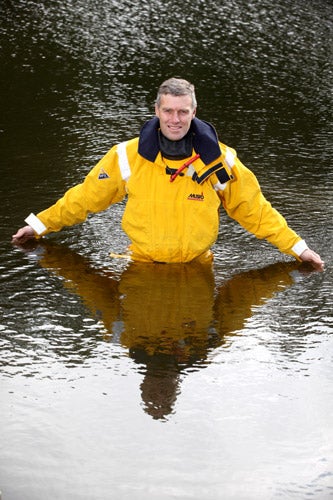First person: 'I survived the Northwest Passage'
Kev Oliver, 4

I have always been intrigued by the history of the Northwest Passage, the fabled northern sea passage between the Atlantic and Pacific oceans. Last year, my friend Tony Lancashire and I decided that in order to raise money for charity, we would attempt to navigate the route in a 17-foot open sailing boat. We set off from Inuvik on the Beaufort Sea on 24 July 2009, travelling east and arriving in Gjoa Haven on King William Island 42 days later.
The scenery itself was rather drab. That area of the Arctic is fairly flat and most of what we saw was sandy shale and tussocky grass with little relief. But the wildlife more than made up for the landscape. In the water, we saw a white Beluga whale, and seals would regularly come and play around the front of our boat. On land, we saw arctic foxes, caribou and musk cats.
One afternoon, while Tony and I were walking back to our boat, we stopped briefly to watch some birds next to the river. Suddenly, a brown shape in our peripheral vision, which we'd thought was a boulder, started running towards us from about 20 metres away. We were being charged by a grizzly bear. I reached for my camera while Tony, who was carrying our shotgun, issued a warning shot, and on hearing that, the bear turned and ran away.
Most nights, Tony or I would sleep up front, while the other rowed or sailed, or we'd drag our vessel on to the beach, sleeping in a tent or in the boat, but that night we ended up anchoring on an ice floe 50 metres off shore. We didn't want to risk the bear coming back again. That was one of the most challenging moments during our journey. Another came two weeks in, when our boat became lodged in ice, the worst ice that had been seen in the area at that time of year for a decade.
On that occasion we found ourselves surrounded by ice floes; the wind was strong and we couldn't predict which direction it would push the floes from one moment to the next, so we had no idea which way to head to escape.
We spent two whole days waiting and thinking and gathering information through our satellite phone. Finally, the weather forecasters at Northwood and the Canadian coastguards told us that there was an area free of ice some 15 miles away, so we began to drag our boat towards that using a pulley system and rollers. It took us two and a half days to reach open water; there was a huge sense of relief once we arrived. The forecast had predicted that it would take two weeks for the snow to melt and we could have been trapped there all that time.
We had some food with us but not a vast amount. By the third day into our trip, our water machine (which converts sea water to fresh water) had broken; thankfully we found that there was drinkable snow water on top of the ice floes. The temperature during our trip ranged from -3C to 6C.
One night, while we were sleeping in a tent on the beach, there was a storm with 40mph winds. That was uncomfortable and one of the rare occasions I felt genuinely concerned. The main aspect of our planning for this trip – apart from getting ourselves into peak physical condition – was to prepare ourselves mentally for every possible eventuality.
Navigating the Northwest Passage more than lived up to my expectations and it was very different to what I'd imagined. The greatest thing about it was that despite living together in such close conditions for six weeks, Tony and I are still best mates and we raised £10,000 for Toe in the Water, an important cause.
For more information about Toe in the Water, which supports injured servicemen and women, or to make a donation, visit toeinthewater.org
Join our commenting forum
Join thought-provoking conversations, follow other Independent readers and see their replies
Comments